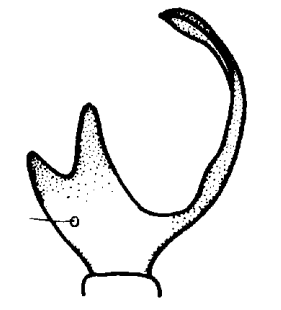Trichoncus vasconicus Denis, 1944
Description
Tibial apophysis with 2 strikingly long processes, appearing parallel (in lateral view). Epigyne with quadrangular to roundish epigynal region. Epigyne wider or equally wide than two times the length of epigyne. Epigynal median part ± pentagonal. Prosoma brown, median spot and radial stripes darker. Legs yellow-brown. Tibia I and II dark brown to black. Opisthosoma black.
Body length male: 1.9-2 mmBody length female: 1.95-2.3 mm
Additional information
Amongst low vegetation in dry and warm localities.
Maybe a synonym of T. affinis (siehe Wunderlich 2011a: 283).
Character states from linyphiid key
Distribution
Phenology
| Jan | Feb | Mar | Apr | May | Jun | Jul | Aug | Sep | Oct | Nov | Dec |
 |  |
Figures
Distribution List
"No references" does not mean that the species does not occur in this country, but that we have not yet inserted the reference for it. We are working on it.
References
Branco V V, Morano E, Cardoso P (2019) An update to the Iberian spider checklist (Araneae). Zootaxa 4614: 201-254 ![]()
Buchholz S (2007) A first contribution to the arachnofauna (Arachnida: Araneae) of the Nestos Delta (NE Greece). Acta Zoologica Bulgarica 59: 241-252 ![]()
Heimer S, Nentwig W (1991) Spinnen Mitteleuropas. Paul Parey Berlin ![]()
Naumova M, Blagoev G, Deltshev D (2021) Fifty spider species new to the Bulgarian fauna, with a review of some dubious species (Arachnida: Araneae). Zootaxa 4984: 228-257 ![]()
Otto S (2022) Caucasian spiders. A faunistic database on the spiders of the Caucasus Ecoregion. Database version 02.2022. Internet: caucasus-spiders.info.
Polchaninova N, Prokopenko E (2019) An updated checklist of spiders (Arachnida: Araneae) of Left-Bank Ukraine. Arachnologische Mitteilungen 57: 60-64 & App ![]()
Rozwałka R, Stanska M (2008) Check-list of spiders (Araneae) of Poland. 1. December 2008. online at http://www.arachnologia.edu.pl/en/species/8-spiders-of-poland.html ![]()
WSC (2025) World Spider Catalog. Version 26. Natural History Museum Bern, online at http://wsc.nmbe.ch (28.2.2025) doi: 10.24436/2 ![]()
Wunderlich J (2011a) Extant and fossil spiders (Araneae). Heutige und fossile Spinnen. Beiträge zur Araneologie 6: 1-640 ![]()



